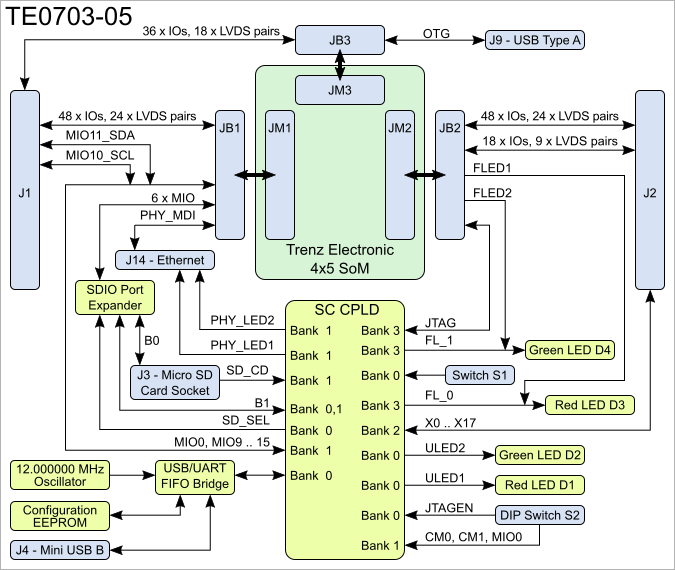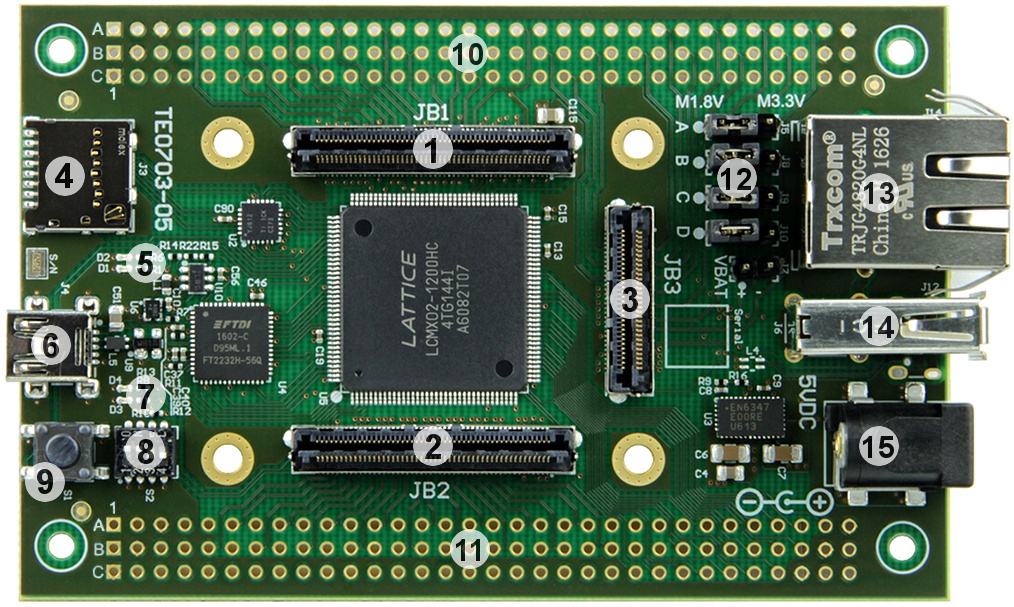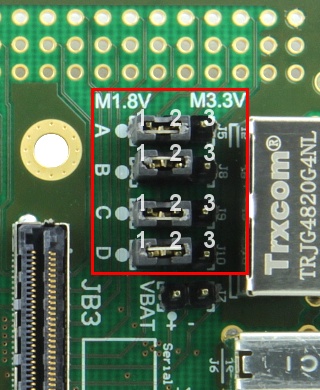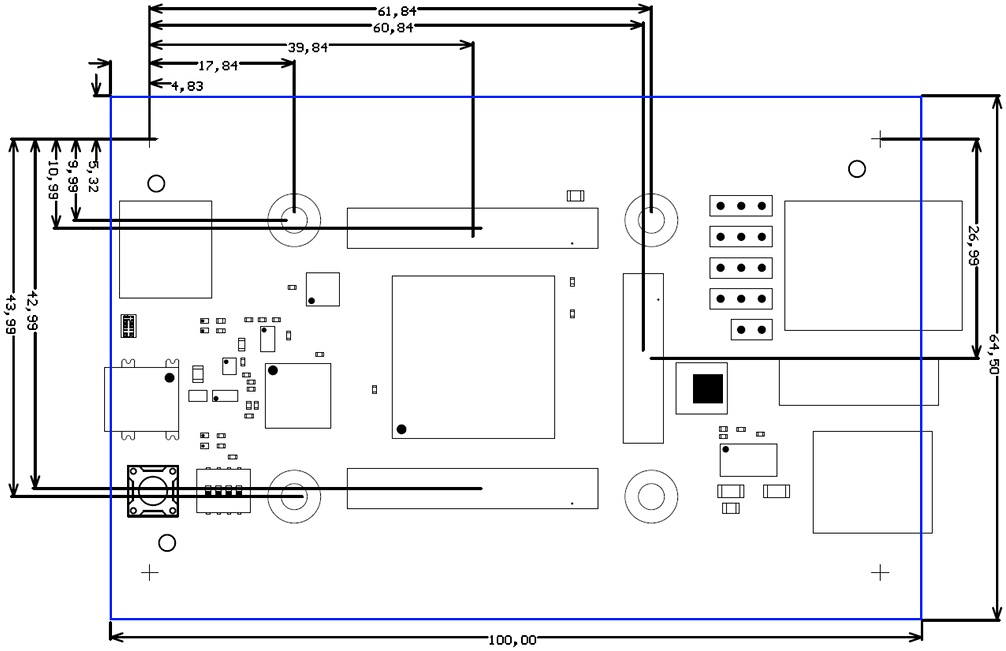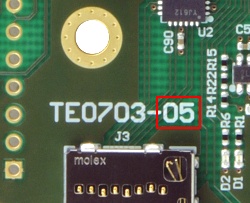Table of Contents
Overview
The Trenz Electronic TE0703 Carrier Board is a base-board for 4x5 SoM's, which exposes the MIO- and the PS/PL-pins of the SoM to accessible connectors and provides a whole range of on-board-components to test and evaluate Trenz Electronic 4x5 SoM's.
See page "4 x 5 cm carriers" to get information about the SoM's supported by the TE0703 Carrier Board.
Block Diagram
Main Components
- Samtec Razor Beam™ LSHM-150 B2B connector, JB1
- Samtec Razor Beam™ LSHM-150 B2B connector, JB2
- Samtec Razor Beam™ LSHM-130 B2B connector, JB3
- Micro SD card socket with detect switch, J3
- LED indicators D1 and D2
- Mini-USB type B connector, J4
- LED indicators D3 and D4
- Configuration DIP switches, S2 (see table under "DIP switches" section)
- User push button (Reset), S1
- External connector (VG96) placeholder, J1
- External connector (VG96) placeholder, J2
- VCCIO voltage selection jumper block, J5, J8, J9 and J10 (see "Power and Power-On Sequence" section)
- Trxcom 1000Base-T Gigabit RJ45 Magjack, J14
- USB type A receptacle, J6 (optional micro USB 2.0 type B receptacle available, J12)
- 5V power connector jack, J13
Key Features
- 2 x VG96 backplane connectors (mounting holes and solder pads)
- SDIO port expander with voltage-level translation
- Micro SD card socket, can be used to boot system
- 4 x user LED's, 2 x red and 2 x green
- Mini-USB connector (USB JTAG and UART interface)
- 1 x user push-button routed to CPLD. By default it is configured as system reset button
- RJ45 Gigabit Ethernet socket with 4 integrated LED's
- USB Host Connector
- Barrel jack for 5V power supply input
- 4A high-efficiency power SoC DC-DC step-down converter(Enpirion EN6347) for 3.3V power supply
- Trenz 4x5 module connector strips (3 x Samtec LSHM series connectors)
- USB JTAG and UART interface (FTDI FT2232H), compatible with Xilinx Tools (also with many other tools)
- 2 x user configurable DIP switches
Initial Delivery State
Board is shipped in following configuration:
- VCCIO voltage selection jumpers are all set to 1.8 V.
- S1 switch configured as reset button in CPLD.
- Two VG96 backplane connectors are not soldered to the board, but they are included in the package as separate components.
- S2 DIP switches are configured as follows:
| Switch | Position | Description |
|---|---|---|
| S2-1 | ON | Mode control MC1. |
| S2-2 | ON | Mode control MC0. |
S2-3 | ON | JTAG enabled for B2B JB1 connector. |
| S2-4 | OFF | Boot mode set to QSPI. |
Different delivery configurations are available upon request.
Signals, Interfaces and Pins
Board to Board (B2B) I/O's
For detailed information about the B2B pin out, please refer to the Master Pin-out Table.
Micro SD Card Socket
Micro SD card socket is connected to the B2B connector through a Texas Instruments TXS02612 SDIO port expander for voltage translation. The Micro SD card has 3.3V signal voltage level while most 4x5 modules use 1.8V for the SD card interface.
USB JTAG and UART
TE0703 has on-board USB JTAG and UART solution based on UART/FIFO controller from FTDI. FTDI EEPROM is pre-programmed with license code to support Xilinx programming tools.
Do not access the FT2232H EEPROM using FTDI programming tools, doing so would erase normaly invisible user EEPROM content and invalidate stored Xilinx JTAG License. On board JTAG would not be accessible any more from any Xilinx tools. Tools from FTDI website do not ask or warn before they erase user EEPROM.
Ethernet
On-board Ethernet jack J14 pins are routed to B2B connector JB1. Ethernet jack J14 LEDs PHY_LED1 and PHY_LED2 are both routed to System Controller CPLD bank 1.
USB Interface
TE0703 board has two physical USB sockets:
- J4 as mini-USB type B socket wired to the on-board FTDI FT2232H chip.
- J6 as USB type A wired to B2B connector JB3 (USB transceiver used depends on the SoM model used).
JTAG Interface
JTAG access to the System Controller CPLD and Xilinx Zynq chip on the SoM is provided via mini-USB JTAG interface (FTDI FT2232H) and controlled by DIP switch S2-3. JTAG signals from System Controller CPLD to the JB2 connector are routed as follows:
JTAG Signal | B2B Connector Pin |
|---|---|
| TCK | JB2-100 |
| TDO | JB2-98 |
| TDI | JB2-96 |
| TMS | JB2-94 |
LEDs
There are four on-board LEDs:
| LED | Color | Description |
|---|---|---|
| D1 | Red | FTDI UART receive activity. |
| D2 | Green | FTDI UART transmit activity. |
| D3 | Red | CPLD signal FL_0. |
| D4 | Green | CPLD signal FL_1. |
LEDs D3 and D4 are also connected to the B2B connector JB2 pins FLED1 and FLED2 respectively and can be controlled by SoM FPGA firmware.
DIP switches
| Switch | ON | OFF | Notes |
|---|---|---|---|
| S2-1 | User configurable, routed to CPLD | User configurable, routed to CPLD | |
| S2-2 | User configurable, routed to CPLD | User configurable, routed to CPLD | |
| S2-3 | JTAG enabled for B2B connector JB2 | JTAG enabled for CPLD | |
| S2-4 | Boot from SD Card | Boot from QSPI flash on module |
Power
Power supply with minimum current capability of 3A for system startup is recommended.
Power Supply
Single power supply with minimum current capability of 3A at 5V for system startup is recommended.
Power Consumption
| Power Input Pin | Max Current |
|---|---|
| VIN | 4A |
Typical power consumption for TE0703-05 + TE0715-01 module with SD micro card inserted, Ethernet connected and link up, system booted into Linux prompt and idling is 5V / 0.55A.
Power-On Sequence
It is not allowed to feed any voltage to any external I/O pin before there is no power indication on M3.3VOUT pins. Presence of 3.3V on B2B JB2 connector pins 9 and 11 indicates that module is properly powered up and ready.
If any of the VCCIOA, VCCIOB, VCCIOC or VCCIOD will be powered through external connectors J1 or J2, then corresponding VCCIO jumper should also be removed altogether, see next chapter.
VCCIO voltage selection jumpers J5, J8, J9 and J10
Refer to the 4x5 Module Integration Guide for VCCIO voltages options.
Jumper J5 | 1-2 | 2-3 | Voltage |
|---|---|---|---|
VCCIOA | ON | OFF | 1.8 V |
| VCCIOA | OFF | ON | 3.3 V |
| Jumper J8 | 1-2 | 2-3 | Voltage |
|---|---|---|---|
| VCCIOB | ON | OFF | 1.8 V |
| VCCIOB | OFF | ON | 3.3 V |
| Jumper J9 | 1-2 | 2-3 | Voltage |
|---|---|---|---|
| VCCIOC | ON | OFF | 1.8 V |
| VCCIOC | OFF | ON | 3.3 V |
| Jumper J10 | 1-2 | 2-3 | Voltage |
|---|---|---|---|
| VCCIOD | ON | OFF | 1.8 V |
| VCCIOD | OFF | ON | 3.3 V |
Technical Specifications
Absolute Maximum Ratings
Parameter | Min | Max | Units | Reference document |
|---|---|---|---|---|
Supply Voltage VCC | -0.33 | 5.5 | V | |
| Operating temperature | -40 | +125 | °C | Lattice Semiconductor MachXO2 family datasheet |
Storage temperature | -55 | +125 | °C |
Recommended Operating Conditions
Parameter | Min | Max | Units | Reference document |
|---|---|---|---|---|
Supply voltage VCC | 4.75 | 5.25 | V | |
| Operating temperature | 0 | +70 | °C |
Physical Dimensions
Board size: 100 mm × 64.5 mm. Notice that the mini-USB jack on the left and ethernet RJ-45 jack on the right are hanging slightly over the edge of the PCB making the total width of the longer side approximately 106 mm. Please download the assembly diagram for exact numbers.
Mating height of the module with standard connectors: 8 mm
PCB thickness: 1.65 mm
Highest parts on the PCB are USB type A jack and ethernet RJ-45 jack, approximately 15 mm. Please download the step model for exact numbers.
All dimensions are given in millimeters.
Operating Temperature Ranges
Commercial grade: 0°C to +70°C.
Industrial grade: -40°C to +85°C.
Board operating temperature range depends also on customer design and cooling solution. Please contact us for options.
Weight
42g - Plain board.
13g - 2 x VG96 connectors.
Revision History
Hardware Revision History
Date | Revision | Notes | PCN | Documents |
|---|---|---|---|---|
2016-09-07 | 05 | Added VCCIO Jumpers | TE0703 | |
- | 04 | Corrected FTDI EEPROM connection | - | TE0703-04 |
- | 03 | Added VCCIO strapping resistors | - | |
- | 02 | First series boards | - | |
- | 01 | Prototypes | - |
Hardware revision number is printed on the PCB board next to the module model number separated by the dash.
Document Change History
Date | Revision | Contributors | Description |
|---|---|---|---|
| 2017-02-21 | Jan Kumann | New block diagram. | |
| 2017-02-02 | V16 | Jan Kumann | New board image with silk screen pin markings for VG96 connectors J1 and J2. |
| 2016-12-22 | V14 | Jan Kumann | Block diagram added. |
| 2016-12-08 | V10 | Jan Kumann | Document structure revised. |
| 2016-12-05 | V5 | John Hartfiel | Corrected Boot Mode table. |
| 2016-09-06 | V1 | Jan Kumann, John Hartfiel | Initial document. |
Disclaimer
Data Privacy
Please also note our data protection declaration at https://www.trenz-electronic.de/en/Data-protection-Privacy
Document Warranty
The material contained in this document is provided “as is” and is subject to being changed at any time without notice. Trenz Electronic does not warrant the accuracy and completeness of the materials in this document. Further, to the maximum extent permitted by applicable law, Trenz Electronic disclaims all warranties, either express or implied, with regard to this document and any information contained herein, including but not limited to the implied warranties of merchantability, fitness for a particular purpose or non infringement of intellectual property. Trenz Electronic shall not be liable for errors or for incidental or consequential damages in connection with the furnishing, use, or performance of this document or of any information contained herein.
Limitation of Liability
In no event will Trenz Electronic, its suppliers, or other third parties mentioned in this document be liable for any damages whatsoever (including, without limitation, those resulting from lost profits, lost data or business interruption) arising out of the use, inability to use, or the results of use of this document, any documents linked to this document, or the materials or information contained at any or all such documents. If your use of the materials or information from this document results in the need for servicing, repair or correction of equipment or data, you assume all costs thereof.
Copyright Notice
No part of this manual may be reproduced in any form or by any means (including electronic storage and retrieval or translation into a foreign language) without prior agreement and written consent from Trenz Electronic.
Technology Licenses
The hardware / firmware / software described in this document are furnished under a license and may be used /modified / copied only in accordance with the terms of such license.
Environmental Protection
To confront directly with the responsibility toward the environment, the global community and eventually also oneself. Such a resolution should be integral part not only of everybody's life. Also enterprises shall be conscious of their social responsibility and contribute to the preservation of our common living space. That is why Trenz Electronic invests in the protection of our Environment.
REACH, RoHS and WEEE
REACH
Trenz Electronic is a manufacturer and a distributor of electronic products. It is therefore a so called downstream user in the sense of REACH. The products we supply to you are solely non-chemical products (goods). Moreover and under normal and reasonably foreseeable circumstances of application, the goods supplied to you shall not release any substance. For that, Trenz Electronic is obliged to neither register nor to provide safety data sheet. According to present knowledge and to best of our knowledge, no SVHC (Substances of Very High Concern) on the Candidate List are contained in our products. Furthermore, we will immediately and unsolicited inform our customers in compliance with REACH - Article 33 if any substance present in our goods (above a concentration of 0,1 % weight by weight) will be classified as SVHC by the European Chemicals Agency (ECHA).
RoHS
Trenz Electronic GmbH herewith declares that all its products are developed, manufactured and distributed RoHS compliant.
WEEE
Information for users within the European Union in accordance with Directive 2002/96/EC of the European Parliament and of the Council of 27 January 2003 on waste electrical and electronic equipment (WEEE).
Users of electrical and electronic equipment in private households are required not to dispose of waste electrical and electronic equipment as unsorted municipal waste and to collect such waste electrical and electronic equipment separately. By the 13 August 2005, Member States shall have ensured that systems are set up allowing final holders and distributors to return waste electrical and electronic equipment at least free of charge. Member States shall ensure the availability and accessibility of the necessary collection facilities. Separate collection is the precondition to ensure specific treatment and recycling of waste electrical and electronic equipment and is necessary to achieve the chosen level of protection of human health and the environment in the European Union. Consumers have to actively contribute to the success of such collection and the return of waste electrical and electronic equipment. Presence of hazardous substances in electrical and electronic equipment results in potential effects on the environment and human health. The symbol consisting of the crossed-out wheeled bin indicates separate collection for waste electrical and electronic equipment.
Trenz Electronic is registered under WEEE-Reg.-Nr. DE97922676.
